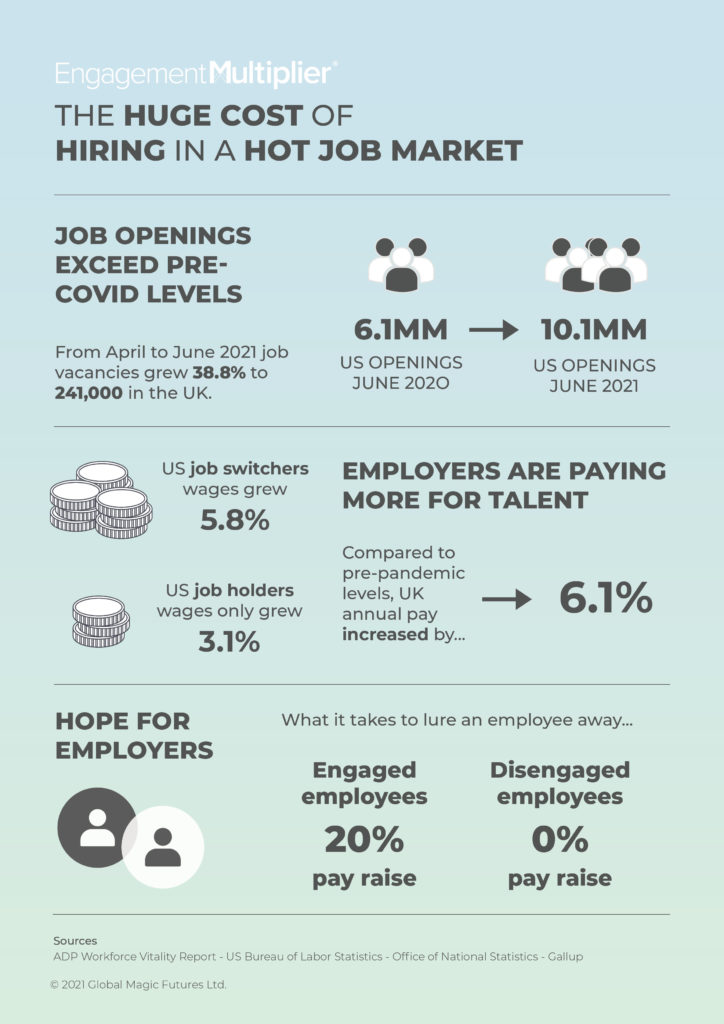Today’s competitive job market means many employers are raising salaries and in some cases, even wind up paying their new hires significantly more than existing employees. In normal circumstances, there’s a healthy gap in the pay scale between new joiners and more experienced people. However, in a competitive job market, conditions are ripe for something called “wage compression” and the various challenges it brings.
Simply put, wage compression occurs when pay for new hires or entry-level staff approaches what longtime staff or senior colleagues make. The risks this situation creates for companies are very real, and if unaddressed, lead to losing employees – at a moment when the talent competition is white-hot.
People talk, and it’s safe to assume that your employees will learn of the differential in salaries between new hires and the rest of the team, and as you’ll see, the costs associated with the knock-on effects will eventually far outstrip the increased spending on the payroll – in fact, the higher wages paid to new hires are just the tip of the cost iceberg.
In the war for talent, someone always has a bigger gun
The war for talent is escalating, and companies are offering unprecedented benefits to new employees, including college tuition, signing bonuses, and other perks, in addition to higher starting salaries.
And there are more “someones” now because competition for candidates is no longer local. Hybrid working is here to stay, and competition for that talent is national (at the very least.)
Our point: competing on salary and benefits quickly becomes a very expensive game.
Your employees are aware
People are realizing this hybrid workforce is real, employer and employee alike – and it’s not lost on your people that there are more opportunities, wherever they live and, for that matter, whatever they do.
In addition to national (and even global) competition for knowledge workers who can work from home or, for that matter, from anywhere, role displacement is now common and increasing numbers of front-line people are changing industries and even careers.
With respect to role displacement, people whose jobs disappeared during the pandemic, such as restaurant wait staff, found new opportunities, such as driving for Amazon. For many, the entry point salary even exceeded their exit point pay levels.
A bulwark against rising salaries
This is where employee engagement becomes a real bulwark against losing people. An engaged employee, according to Gallup, is unlikely to even look at a new job unless the pay differential is more than 20% — however, if they are disconnected and disengaged, that number falls to zero.
Herein is an immediate opportunity for employers. According to US payroll giant ADP, job-switchers gleaned an average salary increase of 5.3%. The industries with the highest average salary increases among job switchers were resources and mining (11.8%), information (9.8%), and finance (7.5%). As rich as those increases are, they are well underneath the average threshold that Gallup identified as the point where a competing offer is seriously considered by an engaged employee.
In effect, a high level of employee engagement functions as a type of “switching cost” that prevents people from leaving the company. Switching costs, defined as the costs incurred when switching brands or providers, are a powerful incentive for the incumbent brand. Similarly, when people find a satisfying role, in a company that aligns with their values, working among people they like, and doing work they feel good about doing at the end of the day, leaving the company becomes risky. It’s not difficult to find a job that pays more money. However, finding a job that you truly enjoy and are fulfilled by is, for many, a real challenge. Of all the powerful benefits an organisation accrues by maintaining a healthy level of employee engagement, the reduction of employee turnover delivers enormous value, in terms of cost savings, healthy culture, and even intellectual capital and competitive advantage.
Competing sustainably for new talent
Leaders of engaged teams have an edge in the job market they may not be aware of: their strong culture, and probable corresponding alignment with purpose, gives them an edge, especially for attracting the kind of people who are likely to have a long and successful tenure, as opposed to the mercenary job-hoppers who switch jobs every 18 months.
Our advice: shift recruiting strategy, and lead with culture and purpose, using their power to attract employees who are more likely to stay for the long haul, and are joining for the right reasons – not a salary bump.
And if you’ve been meaning to revisit purpose and shore up culture, consider the very real and material effect purposeful work has on employees, and move this to the top of the to-do list. A recent study by McKinsey offers remarkable insight into the impact purpose has upon employees and their work outcomes. Key findings:
- 89% of employees want purpose in their lives,
- 70% say their sense of purpose is defined by their work, however,
- 85% of front-line employees do not feel they can live their purpose at work each day.
“When employees at any level say that their purpose is fulfilled by their work, the work and life outcomes they report are anywhere from two to five times higher than those reported by their unfulfilled peers,” noted the study’s authors.
These are big numbers, spelling equivalent opportunities for leaders. Additionally, there is a clear relationship between employee engagement, loyalty, and purpose, according to related research from McKinsey. In fact, when employees feel aligned with the company’s purpose, the impact is significant:
- 87% say they would stay with the company longer
- 77% report feeling engaged
- 93% would advocate for the company.
Creating a sense of belonging and purpose for employees is every leaders’ job, and those who ignore it are more likely to unwittingly disengage employees and compel them to leave. If you need to either focus on your organisation’s purpose or would like to tighten culture by inculcating a sense of belonging amongst employees, we’ve got the resources to assist you:
- Define (or refresh) your company’s purpose with these simple steps,
- The People Charter: Reinforce your purpose and values, and let your team know you care,
- The Era of Belonging: Learn about belonging, its elements, and how to create a powerful sense of belonging within your organisation.
Related Webinar: The Salary Spiral: Competing for Talent Sustainably
Tune in to our webinar, The Salary Spiral: Competing for Talent Sustainably, for more information on sustainable recruiting during a hot job market.




